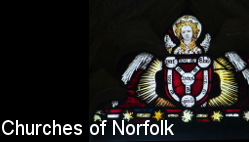
home I index I latest I glossary I introductions I e-mail I about this site
Our Lady of Consolation and St Stephen, Lynford
Follow these journeys as they happen on X/twitter.
Our Lady of Consolation and St Stephen, Lynford On the edge of Norfolk's Stanta Battle Training Area, hidden away in the woods, is the tiny Catholic church of Our Lady of Consolation and St Stephen. It was built for the fabulously wealthy Mrs Yolande Lyne-Stephens in 1878. She lived at Lynford Hall, and, as Pevsner puts it, tired of travelling into Thetford for Mass. Mrs Lyne-Stephens was a retired French ballet dancer and one of the richest women in England, the widow of a man who'd inherited the fortune made by a relative who'd patented moving dolls eyes. In 1860, she received over a million pounds from her husband's will, which is equivalent of about two hundred million pounds in today's money. She's most famous for bank-rolling the vast Our Lady and the English Martyrs catholic church in central Cambridge, which many tourists mistake for a cathedral, as well as Northampton Cathedral, which actually is one, but Our Lady and St Stephen was effectively her private chapel. It served as as a chapel of ease to the church in Thetford, but she also maintained her own chaplain here, not an unusual state of affairs at the time. The church was built in a corner of the Lynford Hall estate, a short carriage ride from the Hall. It's a small building, which makes its bell turret seem overlarge and perhaps a little ungainly. A long flushworked tracery panel at the top of each side echoes a clerestory. A large statue of the Blessed Virgin as the Immaculate Conception sits in a niche above the entrance. The architect was Henry Clutton. He may have had an eye to what had happened on the other side of the woods at West Tofts, where the Pugins, father and son, had transformed the parish church at the expense of the Sutton family, Mrs Lyne-Stephens' predecessors at the Hall. Curiously, there are what appear to be Romanesque reliefs incorporated into the bases of some of the buttresses. The Norfolk churches expert John Vigar tells me that he wonders if they might have come originally from Thetford Priory. You step into a church which at first rather overwhelms you with its darkness. There is a screen at the west end creating a kind of narthex, although there is no font in it or anywhere else in the church. A statue of the Sacred Heart faces eastwards down the church towards an impressive reredos, which may be French in origin. It's hemmed in by a curving altar rail, with a tall east window behind it that Pevsner thought showed the influence of Pugin, for east windows are not commonly found in Catholic churches. The central walkway and sanctuary are carpeted in an imposing fleur-de-lys pattern. The glass in the south, west and north walls depicts pairs of saints, while the east window has a sequence of Annunciation, Visitation, Nativity and Flight into Egypt. There seems to be no record of which workshop made the glass. When Mrs Lyne-Stephens died in the 1890s, the estate was bought by an Anglican, who, Pevsner notes, considered the church to be 'a terrible eyesore', and planted the screens of trees around it to hide it. These, now mature, make the building very difficult to photograph. The adjacent presbytery, originally an 18th Century farmhouse, reverted to being a private house on the death of Mrs Lyne-Stephens. For many years the church continued to serve as a chapel of ease to the Catholic church in Thetford, and housed the Saturday night anticipatory mass for the parish until into the 21st Century. However, along with several other chapels of ease in the Diocese of East Anglia it was closed by Bishop Michael Evans in an attempt to persuade each parish to come together at a single mass station. It's now in the care of the Norfolk Churches Trust, who I'm afraid keep it locked, although I expect this is a condition imposed by the Diocese of East Anglia. Poignantly, the noticeboard still lists the time of the anticipatory mass. Simon Knott, November 2024 Follow these journeys as they happen on X/twitter. |
|
||||||||||||||||||||||||||||||||||||||||||||||||||||||
home I index I latest I introductions I e-mail I about
this site I glossary
Norwich I ruined churches I desktop backgrounds I round tower churches
links I small
print I www.simonknott.co.uk I www.suffolkchurches.co.uk